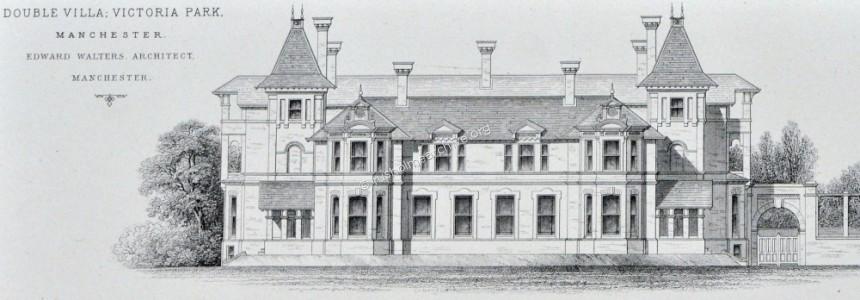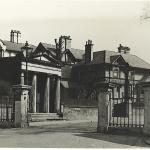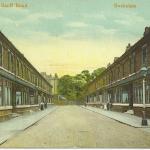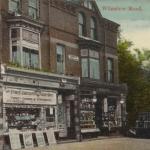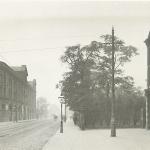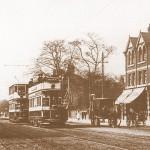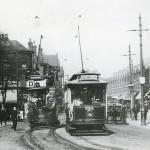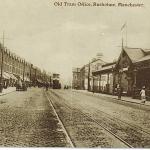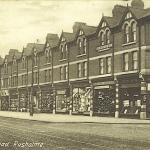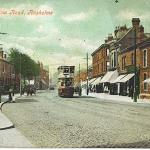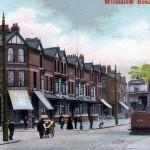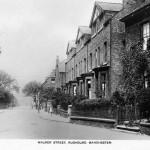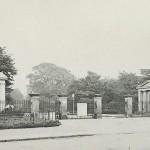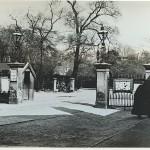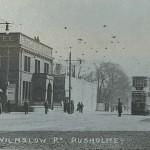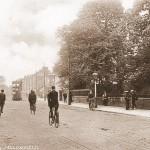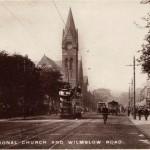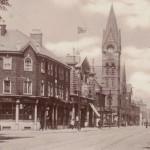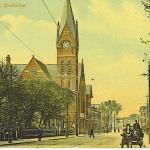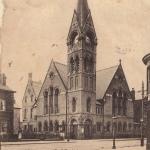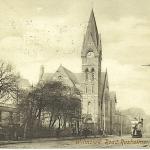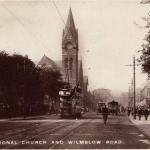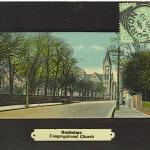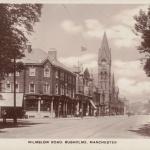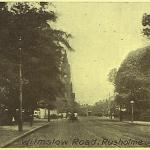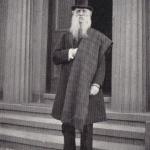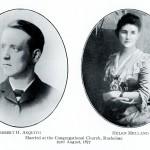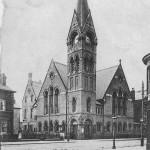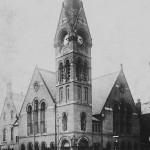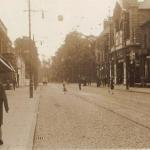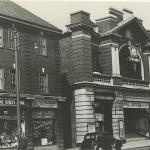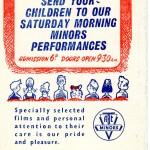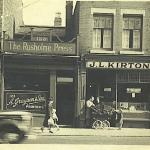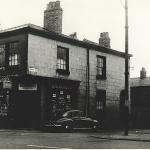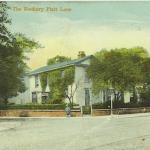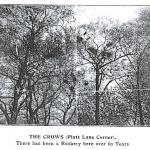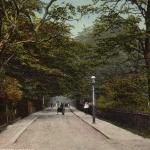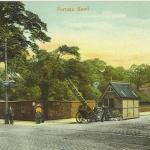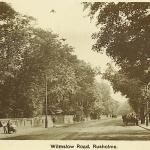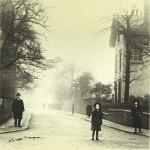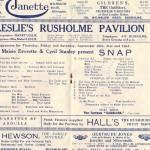Rusholme & Victoria Park Archive
A Tour of Wilmslow Road 1900-20
Wilmslow Road was once referred to by the Manchester Guardian as;
'The broad highway upon which Manchester's merchant princes delighted to live in great houses set back in spacious grounds'.
However even by the beginning of the twentieth century some of the big mansions had been demolished, Rusholme House, Grove House at the beginning of Wilmslow Road had been replaced by the new Whitworth Park & Gallery , whilst Banff House and its extensive grounds was replaced by shops & terrace houses.
Excellent photographs below of Wilmslow Rd, looking north to Manchester taken prior to the first world war, they are all very animated and with fine detail, ranging from the Fairfields Laundry waggon in one picture, to carts advertising soap or Hovis; I find just looking at the detail of people going about their daily business more than a century ago to be quite fascinating. One card is certainly postmarked 1906 and as they feature trams they are not older than 1903. I have shown detail in one or two of the pictures.
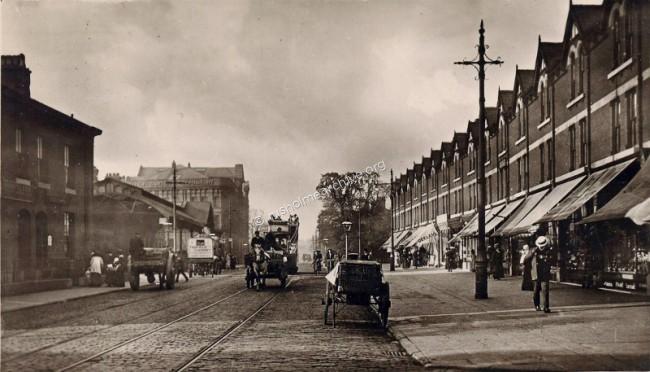
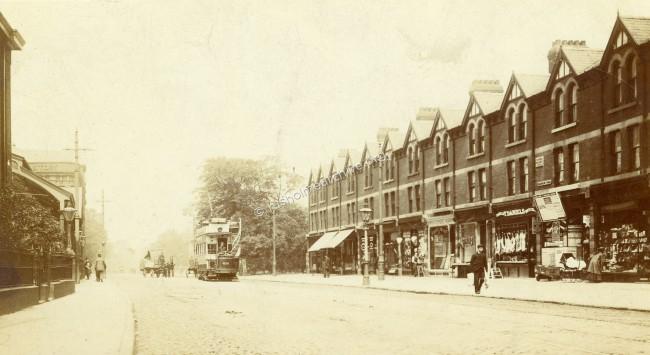
Below a closer view of the above showing the shop frontages
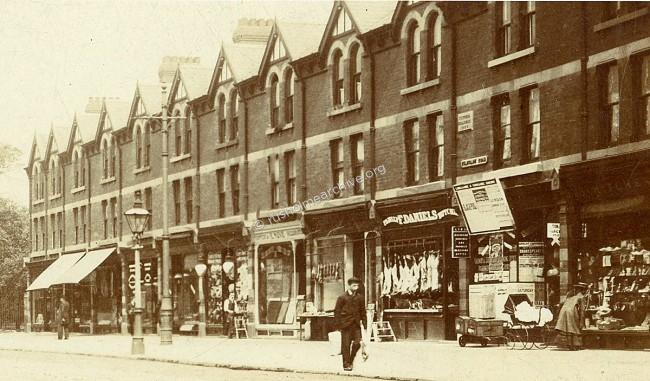
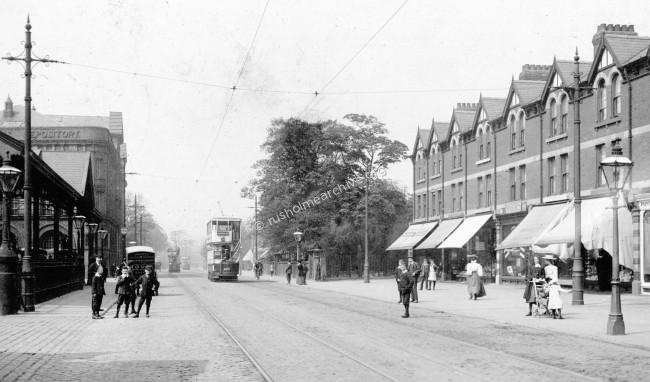
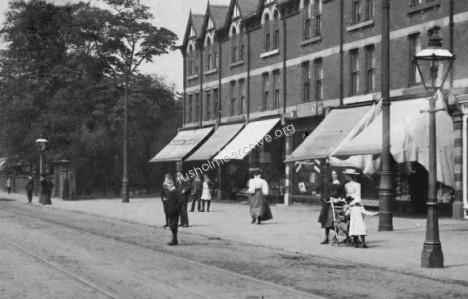
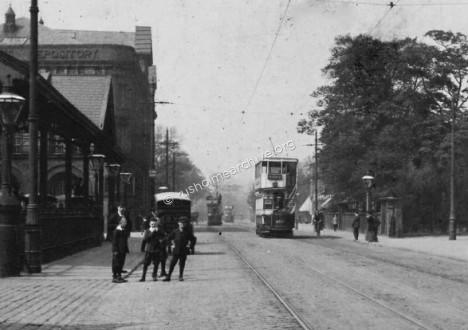
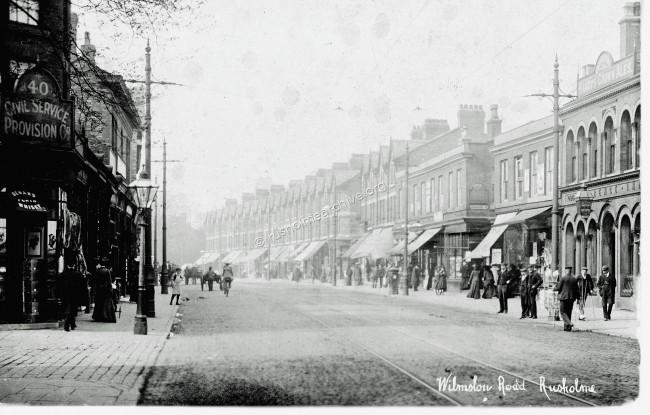
Wilmslow Road is part of an 18th-century route from Manchester to Birmingham & Oxford, hence the more northerly end of Wilmslow Rd being Oxford St & Oxford Rd.
In 1753 the Manchester and Wilmslow Turnpike Trust was created by Act of Parliament, with powers to build, maintain, and improve the most northerly stretch of the Manchester to Oxford route, funded by the collection of tolls. This improved transport link spurred the development of Rusholme in the early part of the nineteenth century. All turnpike trusts in the United Kingdom were abolished in 1881.
The charges that were levied by the Turnpike Trust were not very popular with some of the leading Rusholme residents, particularly those from Victoria Park. In March 1852 a meeting was called to discuss this matter described as 'Grievous' in the local paper.
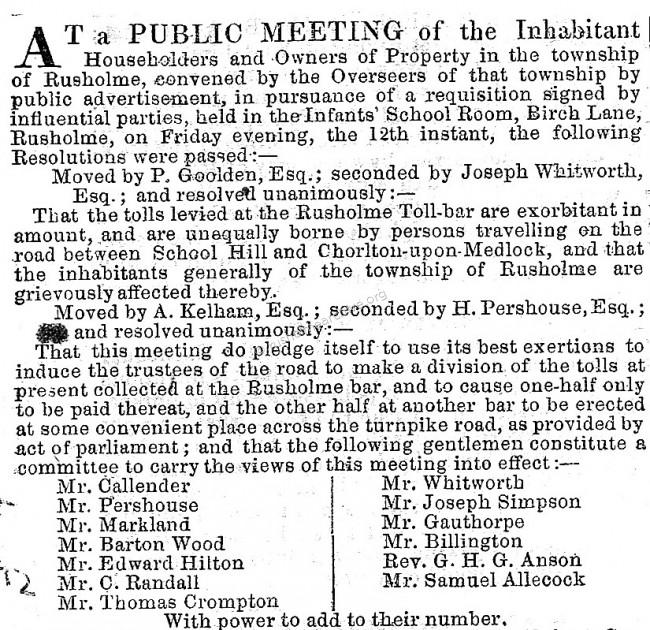
The photograph below was taken by Helmut Petshler and is a view of Oxford Road taken from Rusholme circa 1850 - clearly very rural!
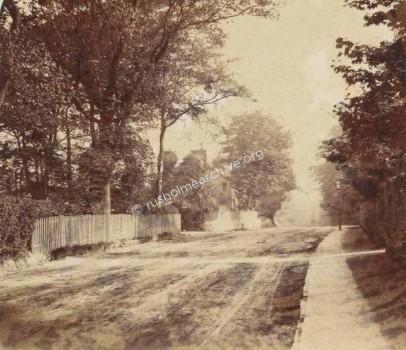
The toll bar for Rusholme was situated just south of Moss Lane and most of the signatories above were clearly living on the southerly side of the tollgate, perhaps in Victoria Park or in the larger houses that had been built on Wilmslow Road. The maps below give an indication of the tollgate, in the larger map the tollgate is in a blue square, the close-up below shows the gate as ‘TB.’
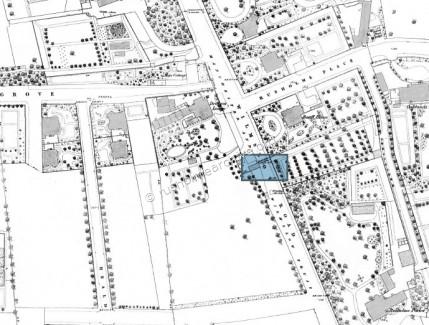
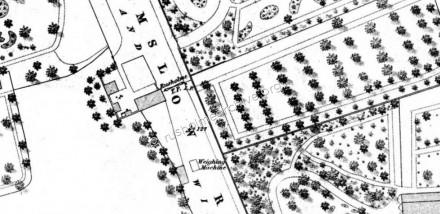
The legislation for the Turnpike Act prohibited the collection of tolls where there were buildings either side of the street. It must have been the case that as the township of Rusholme was growing in the early 1850’s houses stood on both sides of the road and I presume this clause precipitated the court action against the turnpike trustees. Eventually the hearing, before a specially sworn jury was at the Liverpool Assizes in August 1855; (Why you may wonder was it in Liverpool? Rusholme was still in Lancashire and Lancaster served northern districts for senior court actions whilst Liverpool Assizes heard cases in the southern half of the county.)
The jury found in favour of the Rusholme residents and on the 23rd August 1855 the collection of tolls ceased after just over 100 years, the tollbar being moved south to Fallowfield.
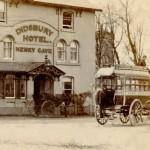 Until the 1870's the traffic on Wilmslow Rd was generally horse drawn carts and coaches. However horse drawn omnibuses were also in use, certainly from 1850 until tramlines were laid. In the photograph on the right, (taken by Helmut Petschler 1860-70) is a horse-drawn omnibus of the City Omnibus company that travelled through Rusholme on its way to Didsbury. The omnibus seen in front of the Didsbury Hotel is presumably awaiting passengers for the return trip.
Until the 1870's the traffic on Wilmslow Rd was generally horse drawn carts and coaches. However horse drawn omnibuses were also in use, certainly from 1850 until tramlines were laid. In the photograph on the right, (taken by Helmut Petschler 1860-70) is a horse-drawn omnibus of the City Omnibus company that travelled through Rusholme on its way to Didsbury. The omnibus seen in front of the Didsbury Hotel is presumably awaiting passengers for the return trip.
In 1877-81 the Rusholme Board of Health obtained Parliamentary powers to lay tracks for horse-drawn trams. The route for the first horse drawn tram from Piccadilly to Rusholme via Oxford Street was opened in November 1880. The fare from Manchester to Rusholme was threepence inside and twopence outside.
After the incorporation of Rusholme into Manchester in 1885 the City Council took responsibility for the tramlines and as part of the development of the Councils electrification of the tramways between 1900-06, Wilmslow Road saw the introduction of electric trams in December 1902.
Further down the page there is more information about the Manchester Carriage Company whose tram depot on Wilmslow Road is seen in many of the postcard views.
The view below of Wilmslow Rd is not the best quality, but quite animated and a good starting point for the tour. On the left is a very familiar site in all postcards of the period, it is the Rusholme Tram shed used by the Manchester Carriage Company. It eventually in 1924 became the site of the Rusholme Repetory Theatre.

After the Manchester Carriage Company closed down in 1903 the disused tram-shed briefly became home to the Manchester Riding School.
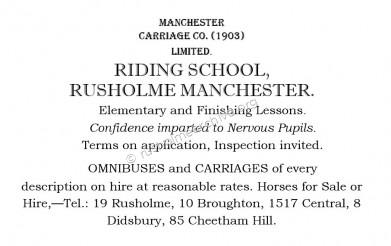
Behind the tramshed there were quite extensive stables for the horses that used to pull the trams. The stables and tramshed were spread over 3.3 acres and provided accommodation for 85 trams and 720 horses. Below is a line drawing of the Manchester Carriage Companys Rusholme depot.
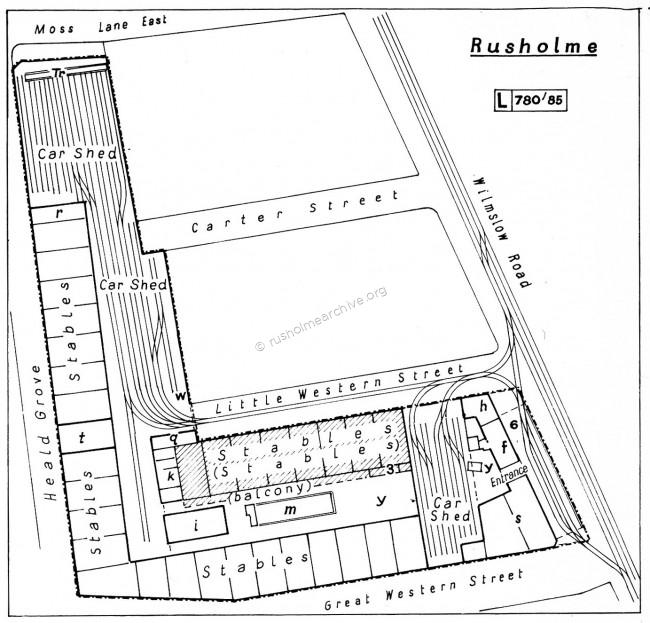
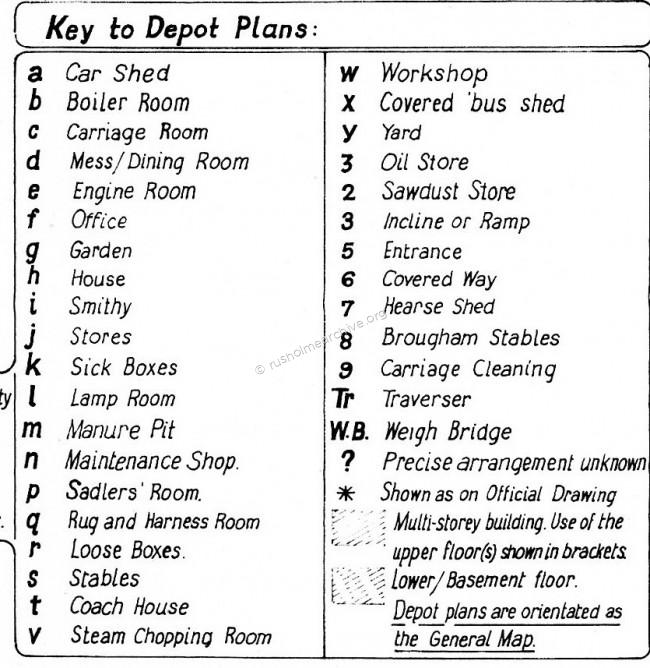
The above drawings are from a history of the Manchester Carriage & Tramways Company. Written in 1977 by Edward Gray it was published by the Manchester Transport Museum Society. I very much appreciate being given permission by the Manchester Transport Museum Society to publish this drawing and the document further down the page regarding the valuation of the Rusholme depot. If you would like to read more about the work of the Manchester Transport Museum Society please follow the link.
The photograph below was taken July 7th 1909 on the occasion of the opening of the Manchester Royal Infirmary which is further north on Oxford Road.
According to the press the formal arrangements for the escort to King Edward VII was provided by the 1st Lifeguards so in the photograph below the troops were presumably looked after in Rusholme as the stables were quite close to the hospital.
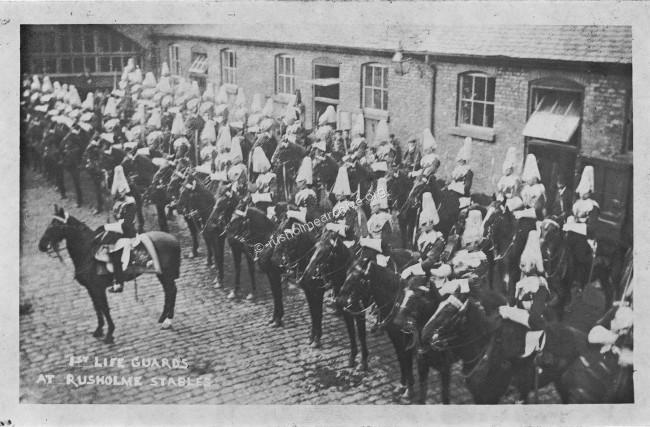
Between Oxford Place and Platt Hall
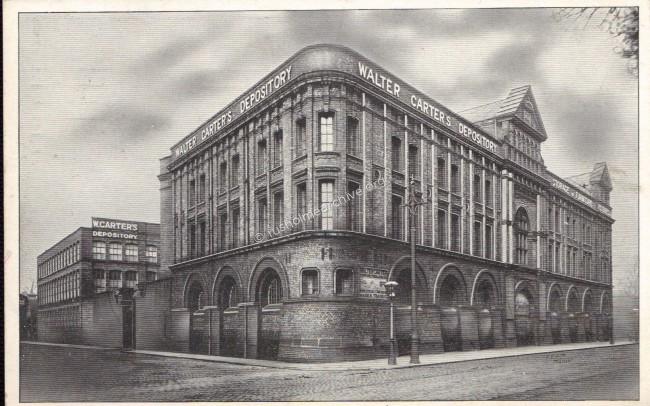
The Walter Carter Depository was built in the mid 1870s. A very imposing industrial building that welcomed you into Rusholme. Below is the message on the back of the card is an order, (dated July 2nd 1908) from Walter Carter to Mr Alderley at Barlow Hall Farm, Chorlton-cum-Hardy. He requests, 'Can you send me one load of best straw in battens on Monday next'. Was that for wrapping items in storage in the absence of bubblewrap?
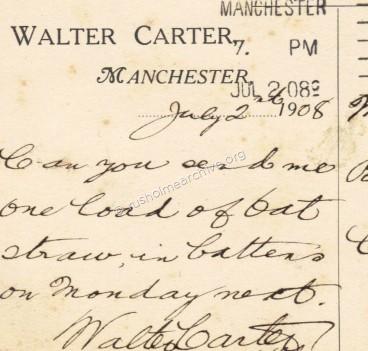
The Clarence Inn below, the card is dated 23rd December 1905. A map of 1848 refers to the Clarence Inn, so it clearly has been there for many years, it is now a restaurant.
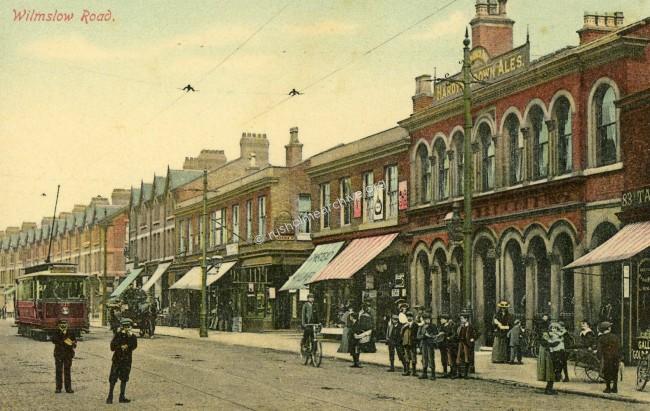
And as a Christmas Card!
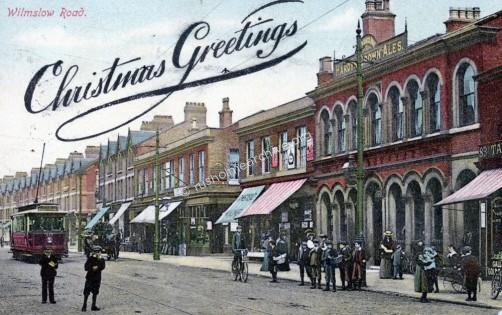
Remember! Wherever you see a 'Gallery' of smaller pictures as below then click on the picture and it will expand!
Gallery above
Oxford Place entrance to Victoria Park shows the gates and the small Lodge probably designed by Richard Lane, the Manchester architect who was one of the Victoria Park promoters. In the background you can see the house known as Woodthorpe.
Banff Road is still with us - comparatively unchanged! Banff House was the home of John Begg Esq, and was a large mansion occupying this site prior to the the construction of the two Banff streets.
Banff Terrace was a small row of shops adjoining, a greengrocer, library/stationery shop & F. Burchill, a jeweller but with a large stack of trunks outside(?).
The fourth card on the top row is another view of Wilmslow Rd, looking north; on the right is a lost feature of the past retail world - a delivery boy with the basket on his arm, card dated Sept 1909.
View below, looking north past Rusholme Theatre on left, to Whitworth Park which is just beyond the Walter Carter depository

The photograph below is perhaps taken from a similar viewpoint, but from the western side of the road and looking south.
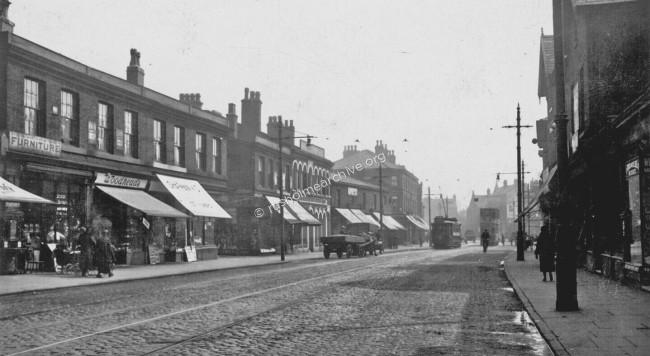
Wilmslow Road Shops offered a very wide range, tailors, furriers, milliners, dairies, bootmakers etc. Below are some advertisements taken from Rusholme Theatre programmes
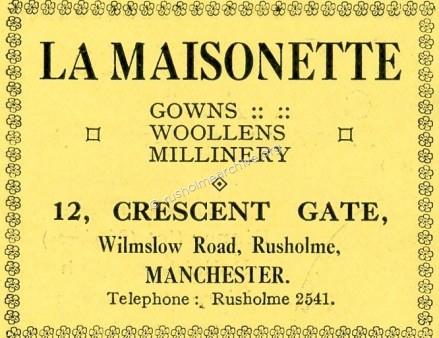
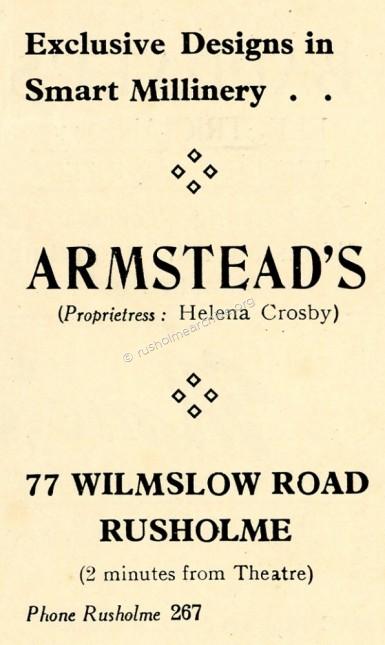
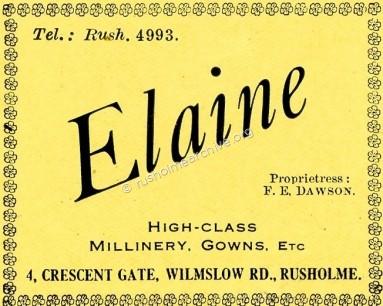
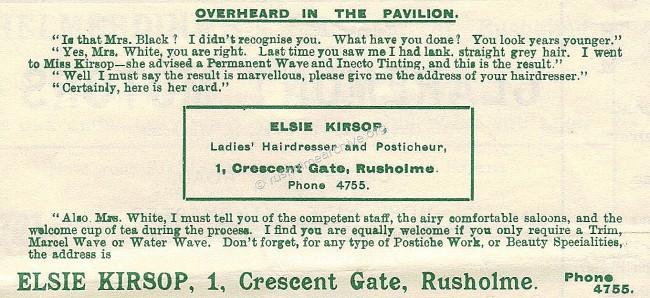

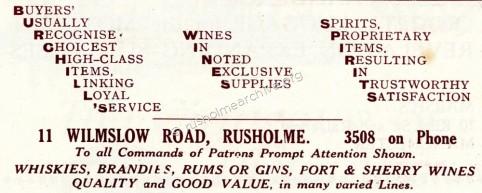
The Manchester Carriage Company Ltd, Rusholme
'Private bus for Theatres, Weddings etc' Tel.No. 19 Rusholme
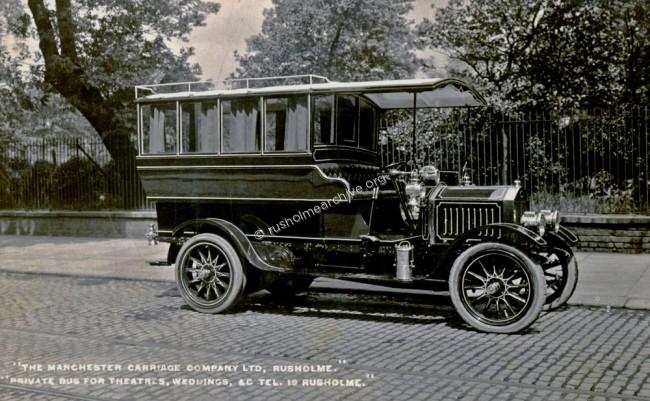
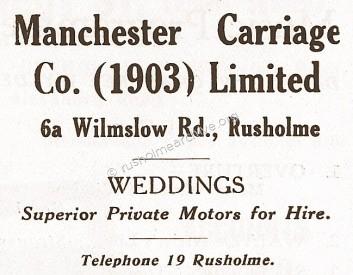
The Manchester Carriage company had quite a long history, it had started in the 1820's as a hackney coaching company in Pendleton. It expanded considerably during the 19th century, providing horse drawn omnibus services, then horse drawn trams throughout Manchester. In 1893 new legislation allowed local authorities to run their own tram services and both Manchester & Salford Councils began preparations to provide a municipal service.
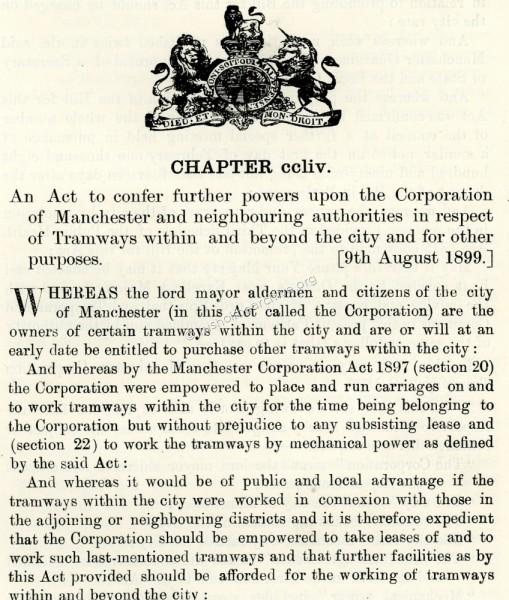
By 1901 there was some agreement about Manchester Corporation taking over the Manchester Carriage tram business. There was however a protracted argument that ended in the courts over the compensation that should be made to the Manchester Carriage Company. By 1903 a payment was made to the Carriage Company by Manchester Corporation of £335,000.00, with other local authorities reaching a settlement with the company through arbitration.
Below is the description and valuation of the Rusholme depot.
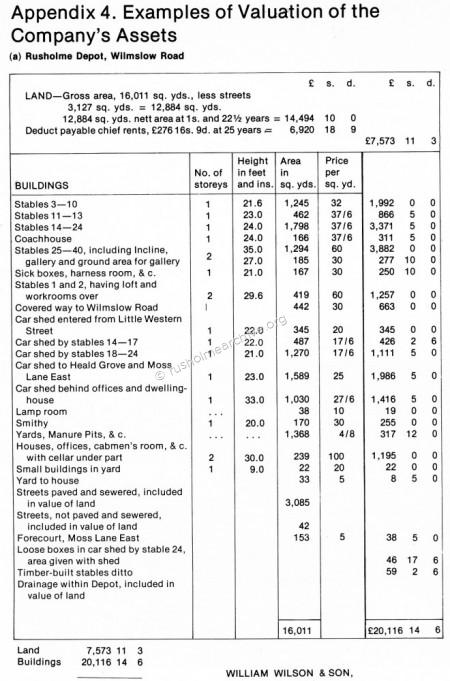

In the photo above taken in Piccadilly you can see in the foreground a horse-drawn tram for Rusholme, via Oxford St & All Saints. As there are no overhead electric wires in this photo it must have been taken prior to 1901 when electric trams first arrived in Manchester. All of the trams in this picture are horse-drawn and it was not until 1903 the last of the horse-drawn trams were withdrawn from use. In 1898 at the Rusholme tram shed the Manchester Carriage Company had experimented with a French manufactured steam driven tram. The Serpollet steam tram was popular in Paris and was twice demonstrated in Manchester leaving the Rusholme depot carrying local dignitaries and members of the Tram Committee into Manchester city centre and back. However Manchester Corporation decided to use electricity to power the new tramcars and the steam tram was scrapped for £19 in 1905.
When the Manchester Carriage Company was formally wound up over one million pounds was distributed to shareholders. All that remained was the small company advertised above that provided private horse drawn carriages and then cars. It continued to operate from the site of the Rusholme tram depot until closing in the 1970's.

The photograph above is a Manchester Carriage Tram Token for 2 pence. This was to ride on the outside, it cost 3 pence to ride inside.
The closure of the Tramways.
The electric trams enjoyed barely 30 years of service before a decision was taken to introduce motor buses. These did not require the infrastructure of lines and over-head power cables and could be rapidly introduced to the newly growing suburban area. I have scanned the document below that was published in 1935 by the Manchester Corporation Transport Department.
An extremely useful booklet that describes public transport in Manchester it covers the first 100 years right through to the withdrawal of tram services. You will need Adobe software to open the file once you havedownloaded it.
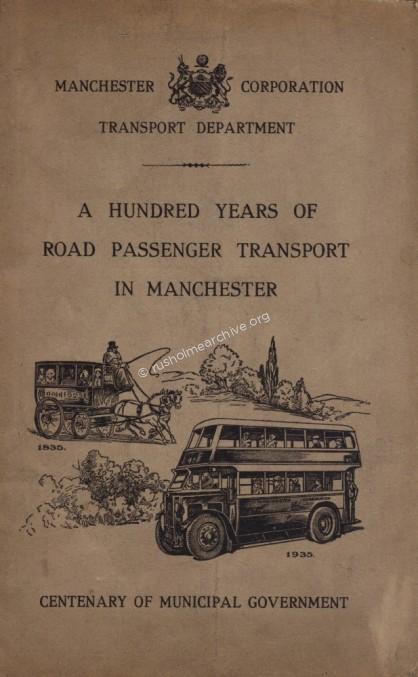
Gallery above, click on the first image to start the gallery
Top row, 2 Rusholme Theatre views, showing the Tram Office that after 1909 was used a cinema & then as Rusholme Theatre. Postcard top right is the Rusholme Bakery and Flour Stores on the corner of Thurloe St
Bottom row, second photo is of Walmer Street houses, demolished some forty years ago & the third photo was the lodge-gate & the Rusholme entrance to Victoria Park, called Crescent Gate, built in 1837 and demolished early in the 20th century. The fourth picture, bottom row was the replacement entrance circa 1918.
The photograph below is looking south along Wilmslow Rd and on the left is the hidden approach to Crescent Gate after it was moved back in 1918.
This photograph was taken in the late 1920's, it still shows a tram in use but now with motor cars on the road rather than horse-drawn vehicles.
This photograph is from the archives from the Greater Manchester Police Museum and I should like to express my appreciation to the museum in allowing me to use this photo.

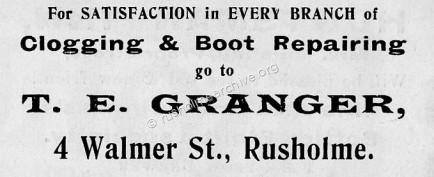
Thurloe Street is home of St Edwards, the Roman Catholic church that was established in 1861. The architect was Edward Welby Pugin (11 March 1834 – 5 June 1875) who was the eldest son of Augustus Pugin. His father, was a famous architect and designer of Neo-Gothic architecture, and after his death in 1852, Edward took up his successful practice. At the time of his own early death in 1875, Pugin had designed and completed more than one hundred Catholic churches including St Edwards in 1861.
The brief history below is taken from the church website.
Early in January 1862, Father Thomas Fox was sent to take charge of the new mission at Rusholme, which had just been opened. The church here was built by him, but it was not designed on a scale to cope with the great population that eventually surrounded it. In those days Rusholme was almost a rural area. Fr. Fox left Rusholme for Clayton-le-Moors in 1873 and Father Peter Vermeulen was Rector until 1876. In 1876 a young Dutch priest was appointed, Fr. Cornelius Vervoort. Unfortunately he was of indifferent bodily strength and died suddenly in 1879 at the early age of 38. The parish benefited from the long rectorship of Mgr. Thomas Croskell, who was here from 1879 to 1913. A well-known figure in the diocese, Monsignor Charles Canon Rothwell, was Rector until 1927. He rendered great service to the diocese by editing The Harvest, a task which he had undertaken in 1892 when Canon Moyes went with Bishop Vaughan to Westminster.
In more recent years the parish remembers the services of Fr. Arthur O'Connor and the late Vicar-General, Monsignor Robert McGuinness.
The parish has long been associated with the College of the Xaverian Brothers, whose property adjoins that of the church.
Interior view below of St Edwards and printed message on rear of card.
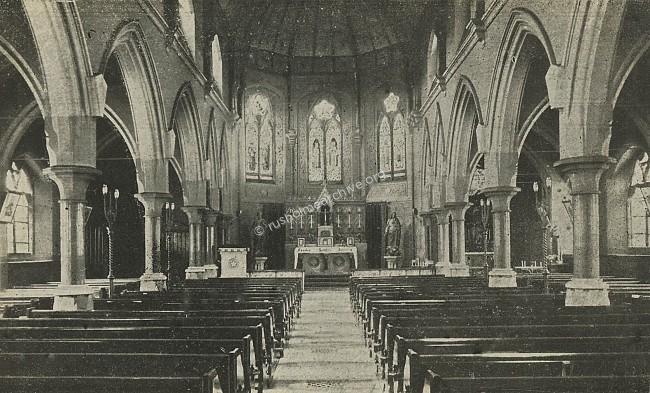
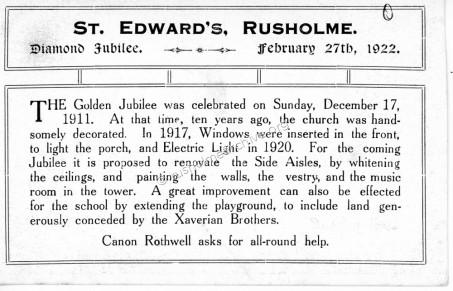
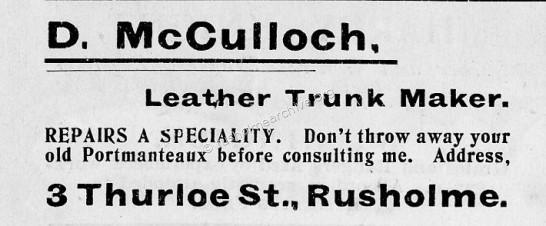
Helmut Petschler photographed this entrance lodge to Victoria Park below in the 1860's.
Helmut Petschler travelled all over the north of England photographing churches and other notable public buildings. He died in 1870 leaving behind an enormous collection of photographs that sadly was broken up. Copies still can be found and provide fine illustrations of buildings around the North West of England.
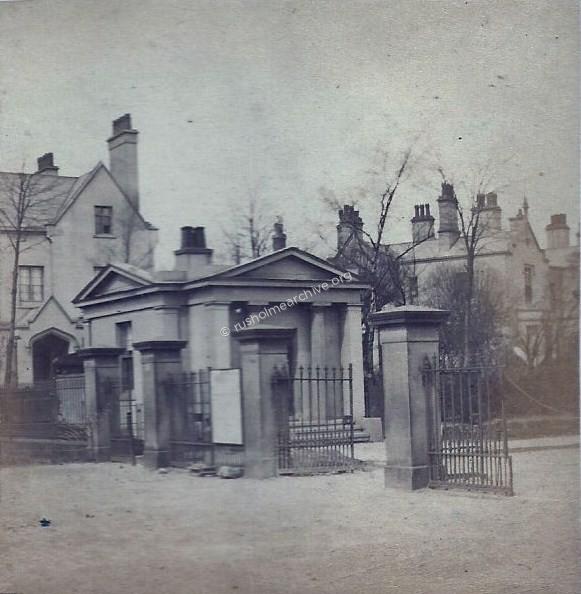
The quite large neo-classical Lodge Gate built in 1837 is no doubt by Richard Lane, the Manchester architect whose work in Manchester was very popular. It was probably demolished in 1905. In the background you can see some of the large houses that were built around Park Crescent, these were also designed by Richard Lane, sadly they have all been demolished except one on the right hand side to the Park entrance - this is still in use as a hotel.
Rusholme Repertory Theatre
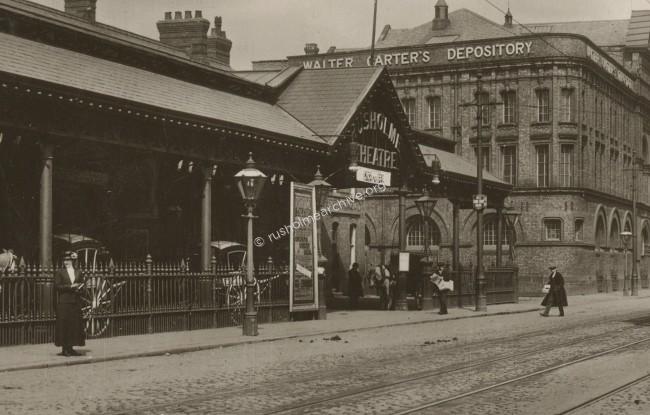
Rusholme Theatre, many successful names have been associated with this this theatre; Wendy Hiller, Joan Littlewood, Helen Cherry, George Coulouris, Pat Phoenix amongst others! After the tram shed closed the premises were used initially as a horse riding school, then as a cinema, and then the repertory theatre opened in 1924.
Below are the prices for the cinema and the theatre.
Cinema price lists below, tram shed converted to cinema approx 1908
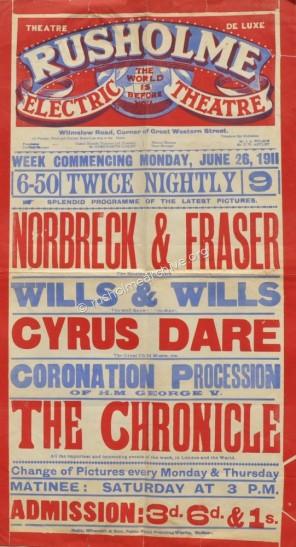
Cinema programme below is undated but careful searching of the Manchester Courier I have found the date was 7th April 1917.
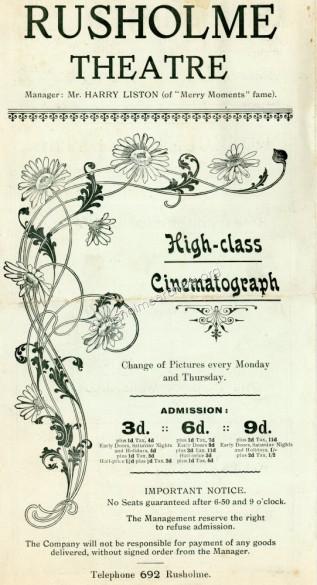
Theatre prices below, cinema converted to theatre in 1924
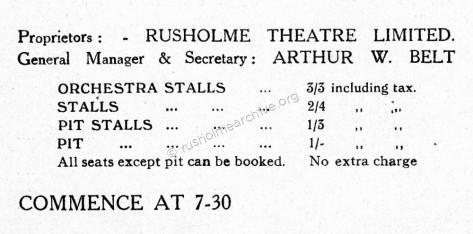
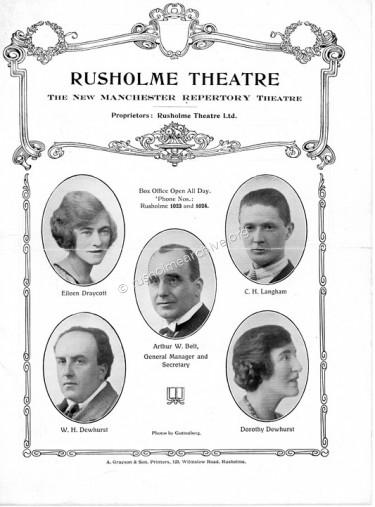
The programme cover above from 1925 (as you can see on the bottom line), was printed by Graysons of 123 Wilmslow Road. If you scroll down to 'Miscellany' you can see a little more.
In the programme below the play is co-written by Ian Hay who was born in Rusholme, (more about him towards the bottom of this page), and amongst the artists Wendy Hiller is playing Cynthia McTodd
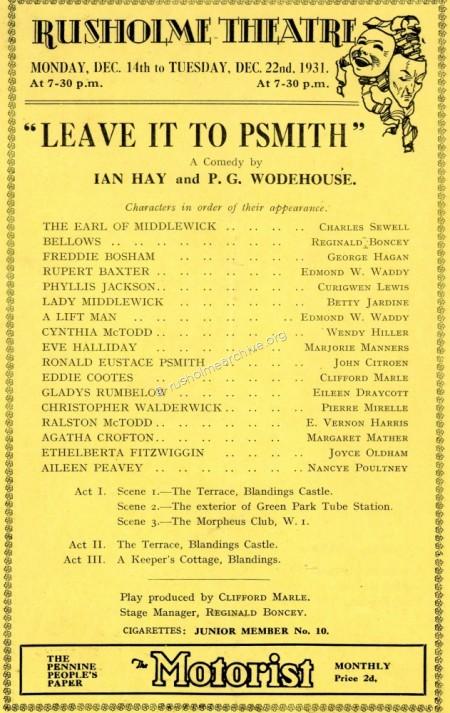
If you would like to read more about Manchester Theatres and their history visit the following website. Remember to click your back button to return to this website.
Wilmslow Road & Dickenson Road Junction
*Opposite Dickenson Road on the westerly side of Wilmslow Road was Gilbodys cottage, in the photograph below is a for sale sign. The cottage was demolished in the 1870's
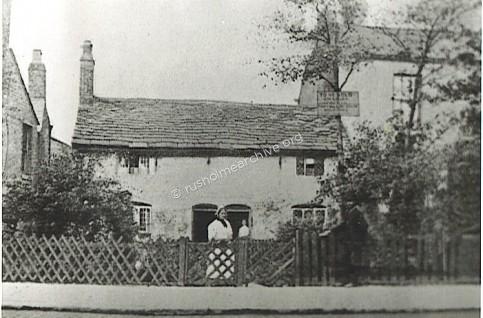
The photograph below was taken in the late 1860's by Helmut Petschler.
This view is looking in a westerly direction, Gilbody's Cottage on Wilmslow Road can be seen in the distance, whilst the newly built Rushilme Public Hall, can be seen on the right.
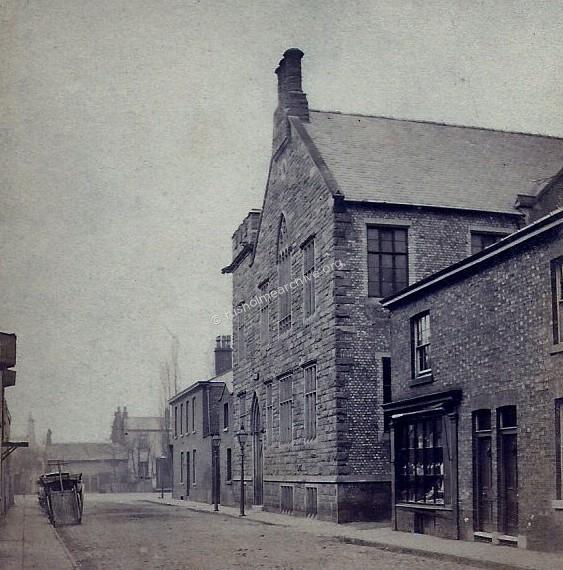
Dickenson Rd junction with Wilmslow Rd below would have been very busy with trams, carts, cars being directed by the policeman on point duty.
The tram stop below was known as 'Finlaysons', so named after the Minister at the Congregational Church opposite, who was the Rev. Finlayson and incumbent for 28 years.
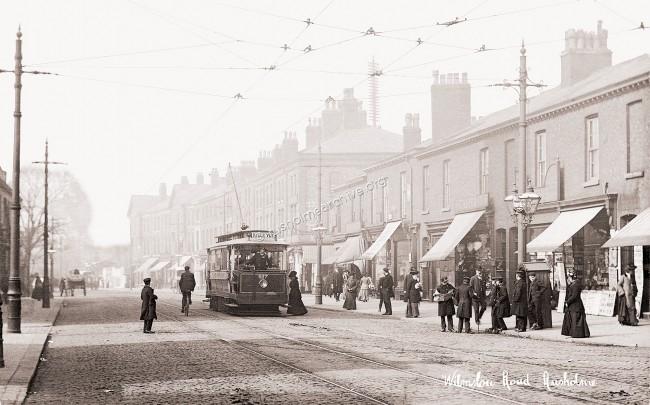
In the photo above, (dated Sept.1904) the tram is heading to Belle Vue and would have turned left into Dickenson Road. In this photograph the tram is almost brand new, records show that No. 517 was purchased in 1903; it is also new to the route, as the tram tracks for the 53 route had only been laid and tested in April 1903.
The route started at Brooks Bar in Moss Side, past Whitworth Park into Wilmslow Road, & then left into Dickenson Road, up to Longsight (crossing the Stockport Rd to Stanley Grove, up to North Rd and then to Kirkmanshulme Lane, and then to Gorton, finally out to Cheetham Hill). This route would mean travelling under the railway bridge at Stanley Grove, but as the bridge was quite low only single-decker trams were used.
The small wooden shelter by the roadside was for the tramboy. He could be busy at this junction to assist and ensure that when the tram turned this fairly sharp corner the tram did not lose power from the overhead lines.
As new posts were needed to suspend the overhead cables gas was also piped through the poles to light the double lamps that were fitted to improve the street lighting.
The row of shops lie between Rusholme Grove & Dickenson Road.
The very tall telegraph pole towards the top centre right may have been for the first Rusholme telephone exchange that was in No.2 Rusholme Grove.
In the far and rather hazy distance on the right it is possible to see the original entrance to Victoria Park.
The following letter to the Editor of the Manchester Guardian was published in May 1892.
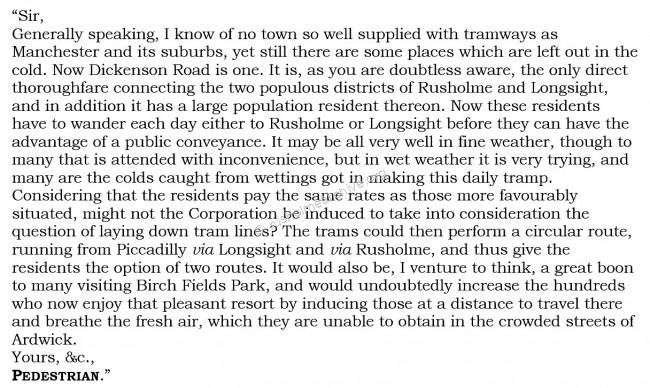
The photograph below is dated 1912 and is looking in an easterly direction along Dickenson Road. The public hall and library is on the left and in the background is the Wesleyan Chapel.
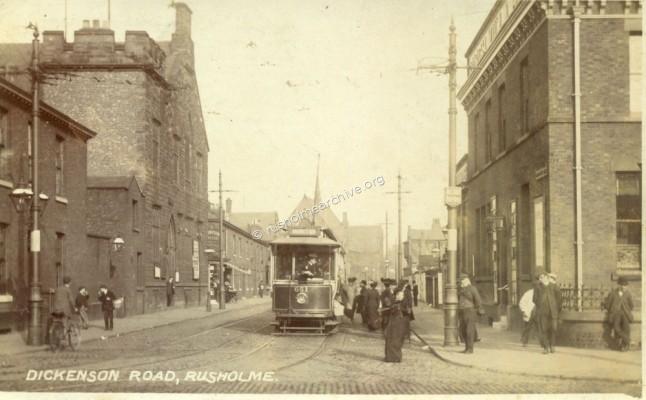
The photograph below is postmarked 1906. Quite similar but one thing that can be seen is a long forgotten male public urinal! If you look towards the rear of Birch Villa, (now Hardys Well) you can see a lantern set on the wall. This is above the entrance to the toilet and presumably provided lighting..................
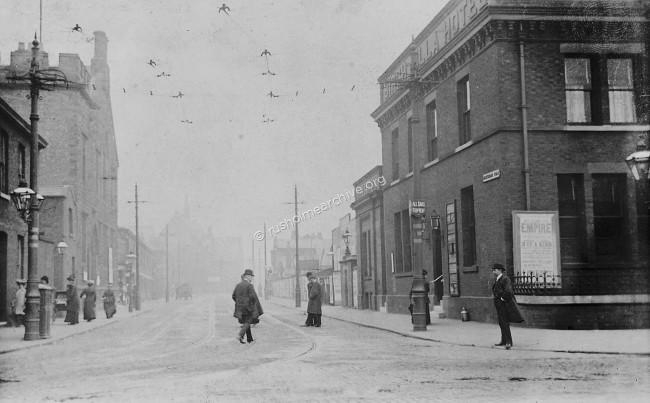
Dated 1904 the postcard view below of the pony and trap on Dickenson Road with the Wesleyan Chapel on the left. The building on the extreme left is the infant school known as 'Little Birch'.
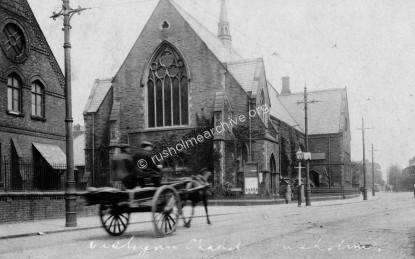
Below are 3 similar views of the chapel and looking east along Dickenson Rd but probably taken in the 1920's.
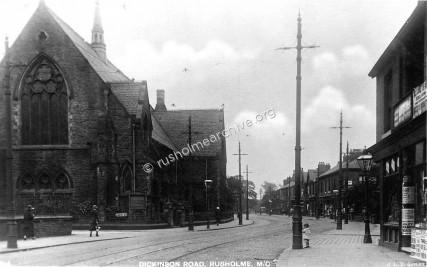
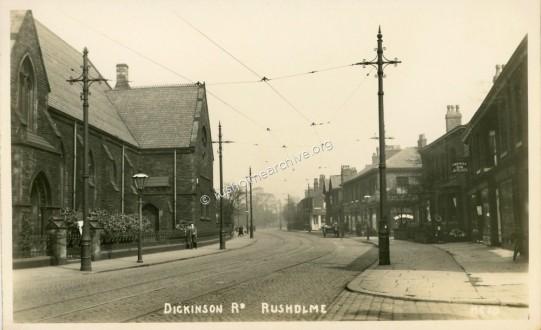
On the row of shops in the photograph above was a local butcher at No.66 Dickenson Road, Frank Hotchin. In the 1911 Census Frank was 32yrs, his wife Lydia 26. They had a young son with them and two young men living there who were shop assistants.

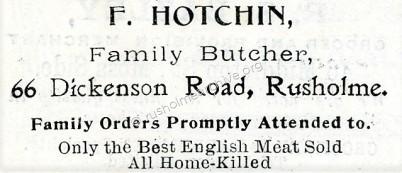
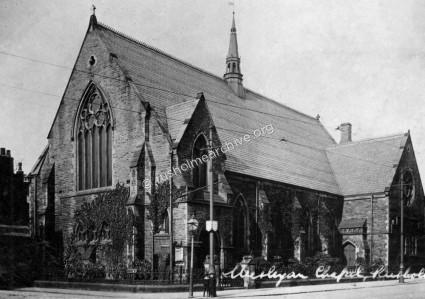
The photograph below of the newly built Wesleyan Chapel was taken by Helmut Petschler in the 1860's.
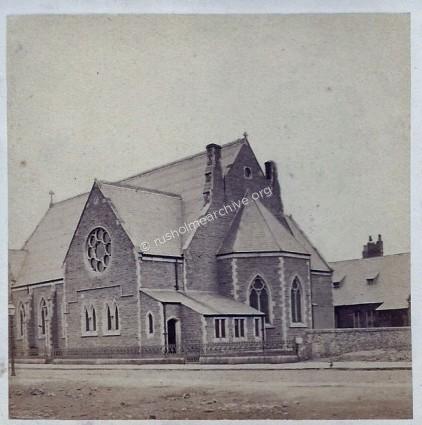
In the view below the tram is on Dickenson Road and heading in a westerly direction towards Wilmslow Road. The position of the tram completely hides Wallace Avenue which is on the left, just further down Dickenson Road on the left you can just see a horse-drawn coach which is at the entrance to Moon Grove.
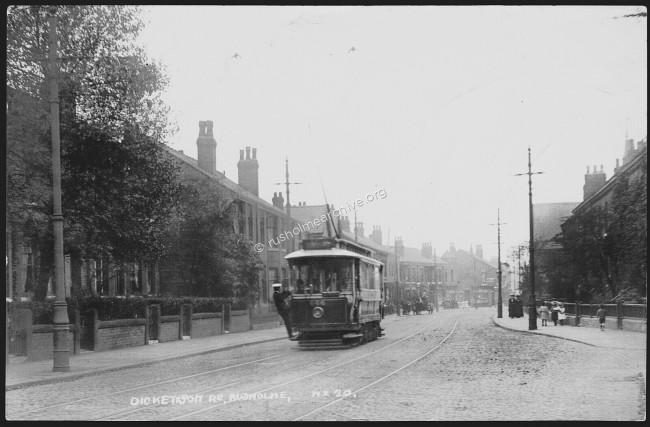
Photograph below by Petschler of the Wilmslow Rd Congregational Church opposite Dickenson Road.
Helmut Petschler died in 1870 so in this photograph the clock is not yet in situ. The long exposure required appears to have allowed a cart to cross the frame and show a 'ghost image.' The church was clearly very popular with other photographers as there are numerous postcards with different views in the gallery further down.
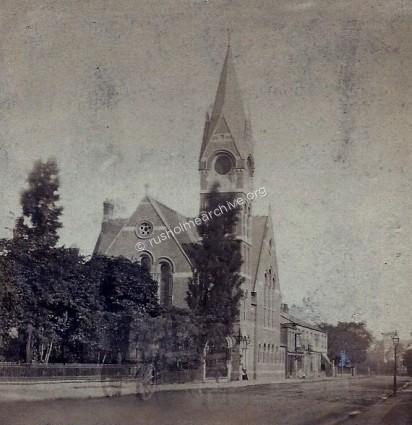
Rusholme Congregational Church was a notable landmark with its tall spire and public clock.
The beginnings of the Rusholme Congregational Chapel, were to be traced to a Sunday-school movement that started in 1839. Apparently a small school of at first forty children was opened in a private house in Nelson Street, Rusholme, removing later to a cottage in John Street, and then to a Baptist chapel in Moor Street. Early in 1853 the Baptist trustees of the building handed it over to the Congregationalists, and a committee was formed to carry on the school and establish an evening service. Some months later a morning service was added, and then the members thought it desirable to form themselves into a church. This was done, and in 1854 the Rev. J. Hardwick Smith, B.A., became pastor.
Afterwards the church passed through years of adversity, and came near to dissolution, but in 1863 a rally was made, and the present structure erected.
It was opened in October, 1864, and in the following year a cordial and unanimous call was given to the Rev. T. Campbell Finlayson, (photograph below), of Cambridge, the author of "The Divine Gentleness," "The Christian Voyage," and other works. Mr. Finlayson was pastor of the church until his early death, and added no less than 315 members. In 1891 the Glasgow University conferred upon him the degree of D.D.
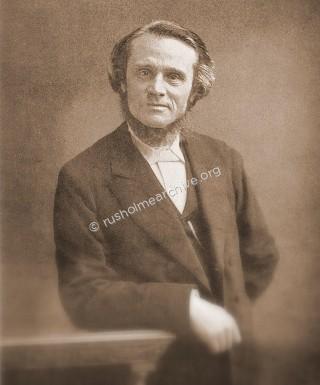
William Royle wrote of Rev. Campbell Finlayson in his History of Rusholme;
""His name is held in pleasant remembrance, for here in our midst he maintained a powerful and effective ministry. He was a man of wide scholarship and deep sympathies, and held with a tenacious grip his religious and political principles. He had a quiet power of attraction, a charming personality, and was loved by all who knew him. Through his writings he addressed a much wider circle than that which assembled in the Rusholme Church. His best known work is, Biological Religion, a criticism of Professor Henry Drummond's Natural Law in the Spiritual World.
That distinguished critic, Dr. Henry Dunckley, wrote in the Manchester Examiner of Dr. Finlayson's book: "We have never seen a finer piece of critical writing." Perhaps his most characteristic work is Koheleth, a practical exposition of the book of Ecclesiastes. The volume of sermons en¬titled, The Divine Gentleness, shows what Dr. Finlayson was as a preacher; and a posthumous volume, Essays, Addresses and Lyrical Translations (Macmillan and Co.), with a delightful biographical sketch, sets forth the man. The Manchester Guardian, reviewing; this volume, said: "Even the casual reader is led to feel thankful that such a man had been known and such a life lived." The sketch was written by Dr. A. S. Wilkins, a distinguished pro¬fessor in our University, and himself a well-known Rusholme resident.
The late Dr. A. Mackennal, in writing of Dr. Finlayson after his death, said "There was no distinction his brethren had to bestow which they would not have given him, and that for two reasons—because they knew him worthy and because of the love in which they held him."
To-day, twenty-one years after he has passed away, his name is revered not only in Rusholme and in our city, but elsewhere; and there are those who still come to Rusholme to see the place where Dr. Finlayson lived and preached.
He died in 1893, one might almost say in his prime, at the age of fifty-seven. His remains were laid in the Necropolis at Glasgow, his native city, the city also of his Alma Mater, which a year or two previously had shown her appreciation of his ministerial and literary work by conferring upon him the degree of Doctor of Divinity."
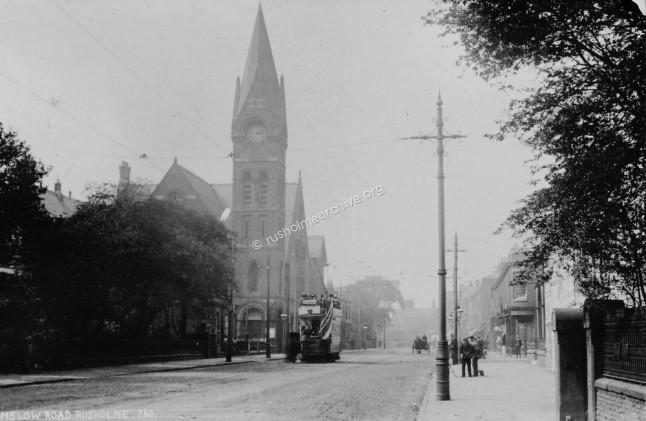
The cost of the church was £4,500 and the architect was Alfred Waterhouse who at that time lived further along the road at Barcombe Cottage on the Oaks estate. At the opening ceremony the Chairman of the building committee said that to produce such an excellent building for this sum was as recommendable to the reputation of the architect as was the beauty of the work itself. It was built in 1864 and had over 600 free seats.
The clock was installed in 1873 and the cost of £476 was provided by public subscription. The church was closed by the end of the 1960s and was demolished in the late 1970s.
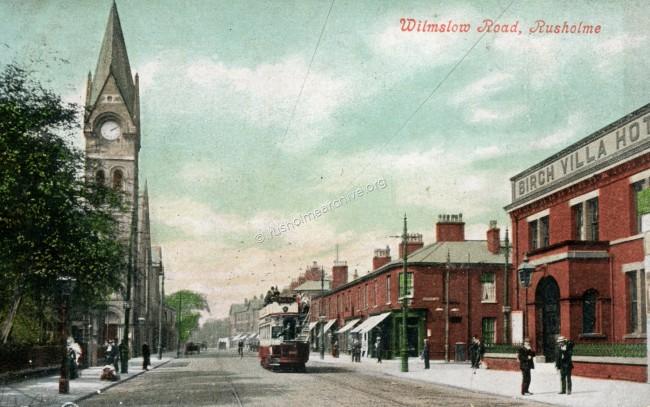
A future Prime Minister, Herbert Asquith wed Helen Melland at the Congregational Church in 1877 and this is the event most remembered here among the many marriage ceremonies. Sadly, after having five children, she died at the young age of 36 from typhoid. Her father was Dr Melland who had helped to build the church.
Dr Melland is referred to by William Royle as follows,
'Amongst those who looked upon Rusholme as their home one of the most distinguished was Dr. Frederick Melland. He was a native of Derbyshire but lived in Rusholme over seventy years. The year of his birth was only two years after the battle of Waterloo and nearly two years before the birth of Queen Victoria. He was the subject of six British sovereigns, closing his days as he began them under a George. "His widest circle of friends is to be found among his old patients in Rusholme. He was a young man when he first went there and he was still at work after he had reached seventy. His neighbours found him to be a public minded man in many ways. He was a keen politician though not a public speaker; he served the Volunteer movement as the surgeon of the corps and he worked hard to establish the Public Library in Rusholme." He had a warm friendship for Dr. Finlayson and "took a large part in building the Congregational Church at Rusholme and a very full part in its services, taking among other things a place in the choir." He was a very striking figure in the village, tall and erect, wearing a shepherd's plaid across his shoulders and with a cheery smile for all his friends, among whom I was proud to count myself. We called him the "grand old man of Rusholme" and so he was. His funeral took place at the Manchester Crematorium on January 21, 1911, and amongst the relatives and friends present was the Prime Minister, Mr. Asquith'
Rusholme Grove, undated view 1910?
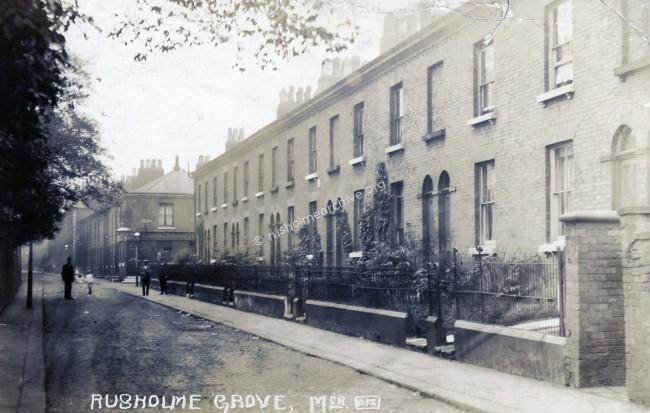
Rusholme Grove above is the last junction on the left of Wilmslow Rd before Dickenson Rd.
Rusholme Grove has the claim to fame that the first Telephone Exchange in Rusholme was at No. 2. Further along the Grove on the right is the 'Welcome Inn'. It was for many years a very popular pub, particularly as it was adjacent to the Dickenson Road Wesleyan Chapel. Not that many of the congregation were likely to have patronised it, but when the chapel fell into disuse, it eventually became the home of Mancunian Films and later the BBC Northern TV studio. The walls of the bars were covered with signed photographs of film & TV stars who had worked in the studios. Diana Dors starred in her first film here but the studio was famous for the northern comics and actors, (Frank Randle & George Formby amongst others), that worked here between 1947 and 1953. Randolph Caldecott, the book illustrator also lived on Rusholme Grove as a young man.

Rusholme Grove below, further east just beyond the Welcome pub, circa 1970.
The photograph shows clearly the houses on the right that were demolished in the early 1970's along with the former BBC studio, previously the Wesleyan church.
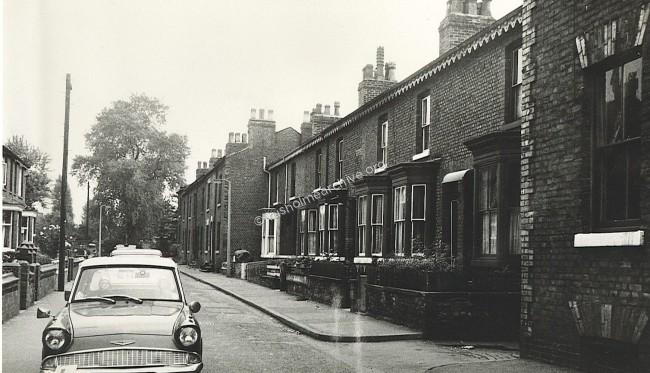
Wilmslow Rd, between Platt Lane & Norman Rd, looking north, 1910-16.
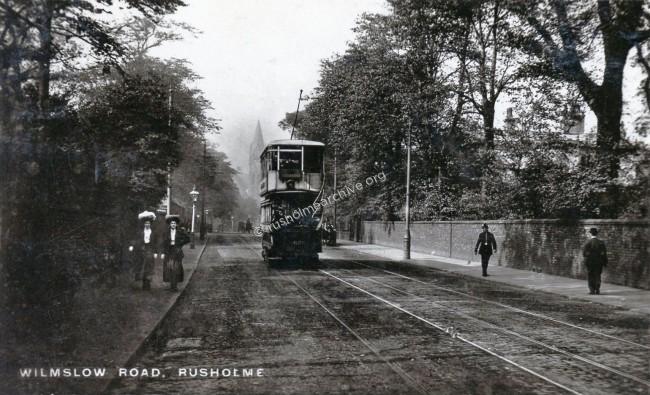
Compare the photograph above & below and you can see how the footpath, (above), on the left-hand side is quite narrow. The old high wall of the Platt Estate on the left is also just discernible. The photograph below, (postmarked 1916), was taken several years later. It shows the benefit of the wider pavement and benches that were provided after the Platt estate was bought by the City Council in 1908 when the estate wall was taken down and replaced with iron railings.
To quote from the Park Superintendents report,
'A broad frontage has been added to the pittance of pavement, so as to preserve a line of fine old elm trees, one of the best decorative effects on our highways. The foliage is so luxuriant in summer that it makes a splendid sunshade, and a number of rustic seats enhances the attractiveness of this leafy and acceptable promenade. So do also the removal of the high brick walls bounding the estate on the north and east.'
In the lower picture it also possible on the right hand side to see over the wall to Platt Abbey.
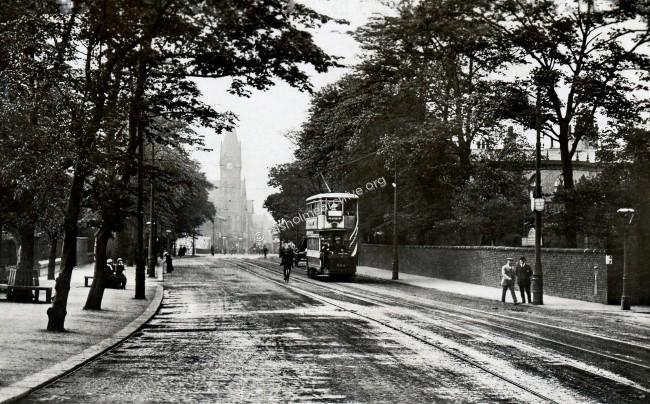
Photographs below, looking south.
The first of the three photographs appears to be taken from perhaps outside of the present Wilmslow Road entrance to Platt Hall. On the left-hand side of the road, looming through the trees you can see the outline of Platt Abbey, and then further down on the left, the junction of Norman Road where the fire-escape station was located. Finally & further along on the left, (and beyond the coach), you can just about see the lodge-gate to Brighton Grove.
The second photograph clearly shows Platt House and then Platt Abbey with the tram obscuring the entrance into Brighton Grove.
The third photograph illustrates the entrance into Brighton Grove - taken sometime in the 1920's prior to the demolition of the lodge-gate in 1935.
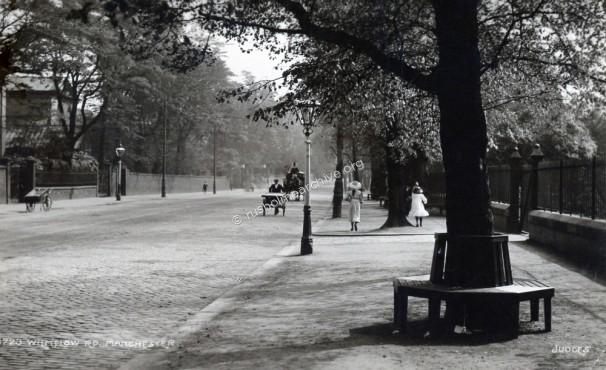
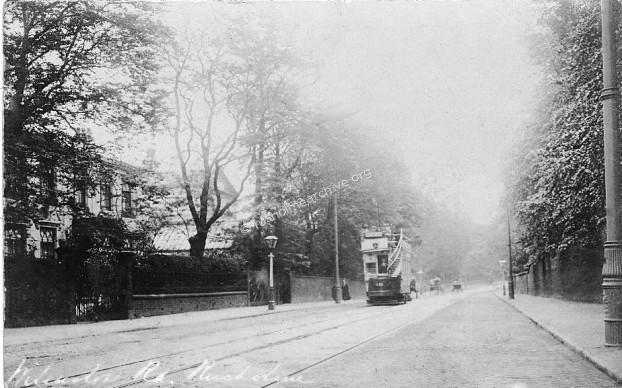
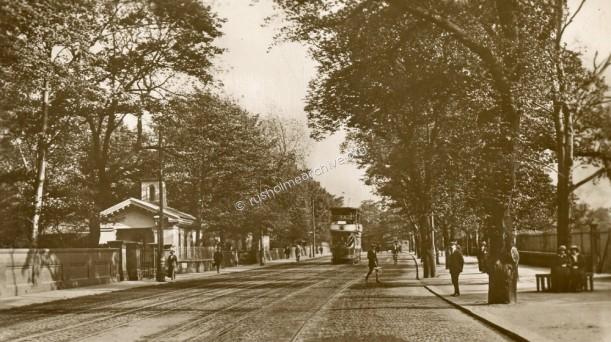
Photograph below, Platt Abbey on the right, Platt House to the left.
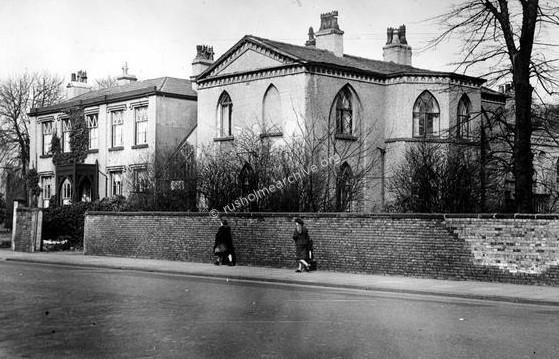
The photograph above has been reproduced from the Manchester Library Archives & Local Studies dept. 'images' collection. I very much appreciate the permission granted to use this photograph.
The two photographs below show more clearly, (in an earlier period), the two homes in the photograph above; Platt House first and below that Platt Abbey.
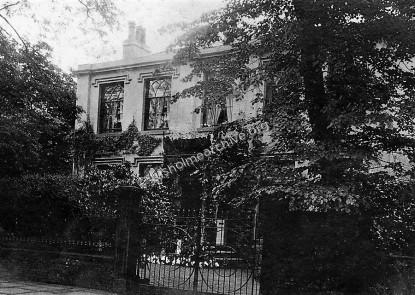
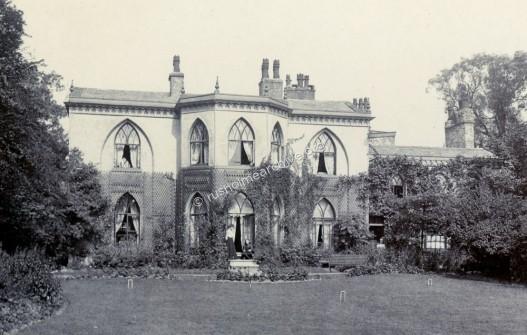
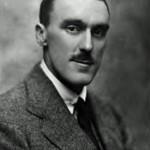 Platt Abbey was a notable building at this point on Wilmslow Road. Built in the early 19th century it was called Platt Abbey but was not believed to have had any particular religious history. It eventually became a hotel, but fell into disuse and was demolished in 1950. The site was intended to be used at the base for the Northern Studios for the BBC but eventually the Manchester City Council built the two blocks of flats that are still on the site. Platt Abbey was the home and birthplace of John Hay Beith, and a blue plaque on the wall of the flats commemorates the event.
Platt Abbey was a notable building at this point on Wilmslow Road. Built in the early 19th century it was called Platt Abbey but was not believed to have had any particular religious history. It eventually became a hotel, but fell into disuse and was demolished in 1950. The site was intended to be used at the base for the Northern Studios for the BBC but eventually the Manchester City Council built the two blocks of flats that are still on the site. Platt Abbey was the home and birthplace of John Hay Beith, and a blue plaque on the wall of the flats commemorates the event.
John Hay Beith (1876–1952), writer, was born on 17 April 1876 in Manchester, the third son and sixth child of John Alexander Beith (d. 1896), cotton merchant and magistrate.
Ian Hay was his pen-name, as a novelist and playwright he was active in the first half of the 20th century. For many years he earned his living as a schoolmaster, only gaining publication in his thirties. He served as an officer during the Great War, ending up as a major.He was a second-lieutenant in the Argyll and Sutherland Highlanders and was in France in April 1915 and was one of the first 100,000 of Kitchener's Army. He was awarded the Military Cross. He was later Director of Public Relations at the War Office (1938-1941). During the twenties and the thirties he blossomed as a writer, with the majority of his work being published during this period.
His work was well known for its wit; often quoted is this line from his play, Housemaster: "What do you mean, funny? Funny-peculiar or funny ha-ha?"
Beith served as Technical Advisor for Cecil B. DeMille's silent extravaganza, "The Little American" (1917), starring Mary Pickford, and was responsible for screenplays/dialogue of fifteen films, including Alfred Hitchcock's The Thirty-Nine Steps and Secret Agent.
He died at Petersfield, Hampshire, on 22 September 1952.
Biographical information from Wikipedia, there is also a comprehensive entry in the National Dictionary of Biography.The photograph inset to the text above is also from Wikipedia.
The portrait below of Maj.-Gen. John Hay Beith CBE, MC was painted by Thomas Cantrell Dugdale and is part of the Garrick Club Collection in Covent Garden, London
I would like to express my appreciation to the Garrick Club in allowing me to reproduce the image.
Maj.-Gen. John Hay Beith CBE, MC
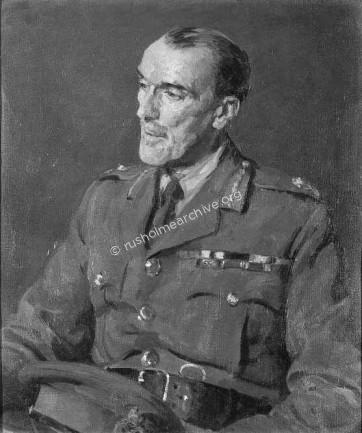
A 'Miscellany' of Wilmslow Rd, Platt Lane & Dickenson Rd junction postcard views
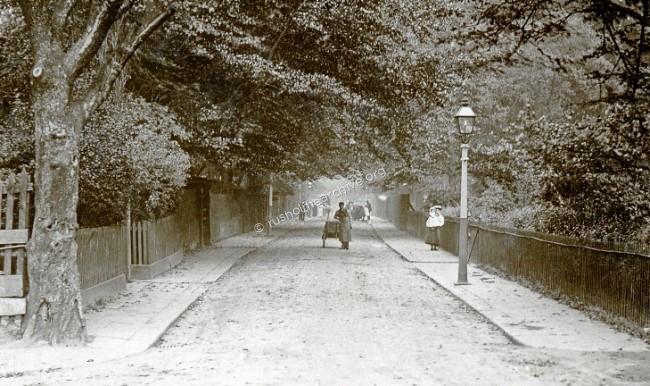
In the view above of Platt Lane circa 1905, it is clearly a quiet country lane. Access to the 'old Rusholme village', away to the left, was from a footpath just to the left. Platt Lane was a cul-de-sac, not being opened up until the construction of the new houses away to the west at Eileen Grove.
The Casino was a dance hall & cinema. The first 5 images in the gallery below are about the Casino. The back of the 20s postcard refers to Mr Walker the dance manager. Located at the corner of Stone Place, opposite Dickenson Road there had been a cinema operating on this site since 1916. The Casino Cinema was built in 1922, the company, starting life in 19211with a capital of £20,000.00, a substantial sum of money. The directors were a Mr Taylor, Mr Kanter and Mr Grundy who acquired the freehold building site, "to erect thereon, a picture palace, ballroom and cafe'. It was one of the new breed of ‘super cinemas’ being built at that time, and opened on 6th March 1922.
The exterior of Casino Cinema had a curved recessed bay, with a central section containing an arched window topped by a pediment. Seating was provided in stalls and circle levels and the proscenium was 35 feet wide. The cinema boasted a ballroom and a cafe. It was taken over by the Associated British Cinemas(ABC) chain on 1st July 1929.
It was a successful until the night of 20th October 1960, when it was destroyed by a fire.
The other images in the gallery above are;
Grayson, the printers.
The Trocadero cinema, closed in the 1970s.
The Rookery, one of these homes belonged to Dr Melland, a prominent Rusholme citizen. The property was known as Melbourne House. When Dr Melland died in 1911 the Prime Minister, Asquith, his son-in-law, attended the funeral. The properties were demolished and replaced by the apartment block, Rusholme Gardens.
Platt Lane in an easterly direction, Platt Hall away to the right.
Rusholme Fire Station circa 1912 on the corner of Norman Rd & Wilmslow Rd; apparently there was always a cart & ladders with a fireman at this point, ready for any emergency! (See page about Birch fire station)
Platt Lane at the junction of Wilmslow Rd, Melbourne House on the right, looking in a westerly direction.
Harry Leslie's Rusholme Pavilion was established on a site next to Birch Villa 1908-09. Comedy shows from the sea-side ran here nightly until 1941. There will be a separate page about the Rusholme Pavilion.
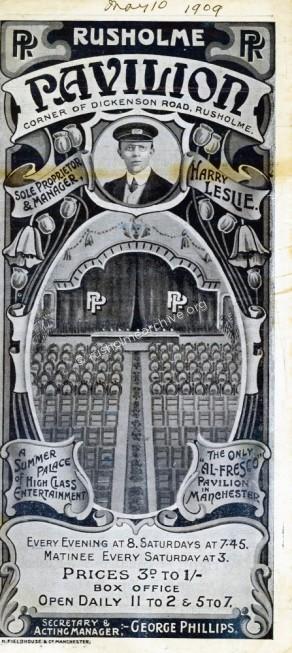
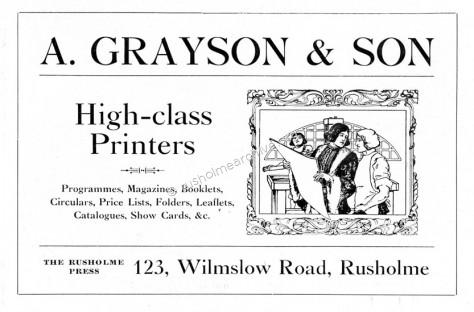
The Rusholme Press was Grayson, the printers, an indispensable trade on every High St, but now perhaps largely defunct because of computer technology.
